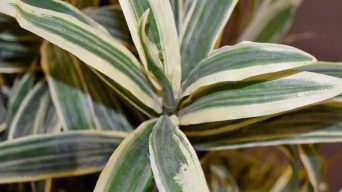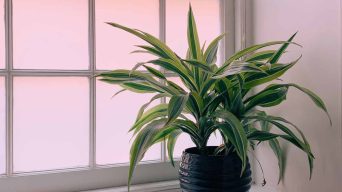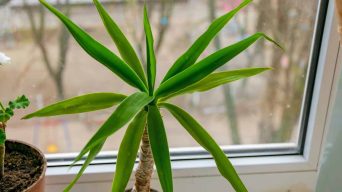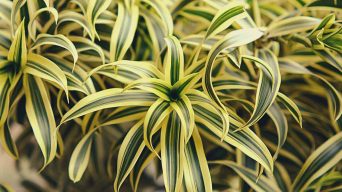Dracaena plants are popular houseplants that are known for their low-maintenance care requirements.
However, even though they are tolerant of neglect, they can still suffer from underwatering.
Underwatering is a common problem with houseplants, and it can be difficult to spot the signs.
However, learning how to identify, treat, and prevent underwatering is essential to keep your dracaena plant healthy.
Why Is Underwatering a Problem?
Water is vital for plants because it helps them transport nutrients and minerals from the soil to the leaves.
It also helps to create energy and food for the plant through photosynthesis.
When a plant is underwatered, the roots cannot absorb enough water to transport these essential nutrients and minerals.
This can lead to several problems, such as:
- The plant stop growing
- The growth is stunted
- The roots start to die
- The plant becomes more susceptible to pests and diseases
- The plant may eventually die
How Does Underwatering a Dracaena Occur?
Underwatering problems usually occur when the plant is not getting enough water or the roots cannot absorb enough water.
There are several reasons why this might happen, such as:
Inadequate Watering
One of the most common reasons for underwatering is simply not giving the plant enough water.
This is often due to forgetfulness or busy schedules.
It’s essential to ensure that you are regularly watering your dracaena plant and giving it enough water each time.
If the roots are not being watered deeply enough, they will not be able to absorb enough water to meet the plant’s needs.
This can eventually lead to underwatering.
Dracaena plants need about 1 inch (2.5 cm) of water per week.
If you are unsure how much water your plant needs, checking the soil before watering is a good idea.
The soil should be moist but not soggy.
If it feels dry to the touch, it’s time to give the plant some water.
Improper Drainage
Another common reason for underwatering is improper drainage.
The roots will become waterlogged and suffocate if the pot does not have good drainage holes.
This can prevent the roots from absorbing the water they need, even if the plant is regularly watered.
To prevent this problem, ensure that your pot has adequate drainage holes.
You can also add a layer of gravel or pebbles to the bottom of the pot to improve drainage.
Hot, Dry Weather
Hot, dry weather can also lead to underwatering problems.
The heat can cause the soil to dry out quickly, and the roots will not be able to absorb enough water to meet the plant’s needs.
If you live in an area with hot, dry weather, you may need to water your dracaena plant more often.
You may also need to mist the leaves to help keep them moist.
Too Much Sunlight
Dracaena plants need bright indirect light to thrive.
However, too much direct sunlight can cause the soil to dry out quickly.
If the plant gets too much sun, it will wilt, and the leaves may turn yellow.
If you think your dracaena plant is getting too much sun, move it to a shadier spot.
You may also need to water it more often.
Repotting
Repotting can also lead to underwatering problems.
If you repot a plant into a pot that is too large, the roots will have too much space, and the soil will stay wet for longer.
This can cause the roots to rot and the plant to become waterlogged.
To prevent this problem, make sure you repot the plant into a pot that is slightly larger than the previous one.
Only repot the plant when it is necessary.
Diseases
Certain diseases can also cause underwatering problems.
For example, dracaena root rot is a common problem that can occur when the roots are waterlogged.
This disease can cause the roots to rot and eventually die.
Fusarium wilt is another disease that can affect dracaena plants.
This disease causes the leaves to wilt and the plant to eventually die.
Pest Damage
Pest damage can also lead to underwatering problems.
Pests can damage the roots, preventing them from absorbing water.
They can also eat the leaves, causing the plant to lose moisture.
If your dracaena plant is infested with pests, you will need to treat the plant and remove the pests.
Wrong Potting Mix
Using the wrong potting mix can also lead to underwatering problems.
The roots will become waterlogged and suffocate if the potting mix does not drain well.
To prevent this problem, make sure that you use a potting mix that drains well.
You can also add a layer of gravel or pebbles to the bottom of the pot to improve drainage.
How To Tell If Your Dracaena Plant Is Underwatered
It’s essential to tell if your dracaena plant is underwatering.
If you catch the problem early, you can take steps to fix it and save your plant.
However, if the problem is not caught early, it can lead to severe damage or even death.
Signs of an Underwatered Dracaena Plant
You can look for several signs to tell if your dracaena plant is underwatering.
These signs include:
Drooping Leaves
Drooping leaves is one of the most obvious signs of an underwatered dracaena plant.
The Dracaena leaves will start drooping and sagging if the plant is not getting enough water.
This is because the plant cannot get the moisture it needs from the soil.
If you see this sign, you should water your plant immediately.
Yellow Leaves
Another sign of an underwatered dracaena plant is yellow leaves.
The leaves may turn yellow or brown if the plant is not getting enough water.
This is because the plant cannot get the nutrients it needs from the soil, and the plant won’t be able to produce chlorophyll.
If you see this sign, you should water your plant immediately.
Wilting Leaves
Wilting leaves is another sign of an underwatered dracaena plant.
The leaves will start to lose stiffness and sag if the plant is not getting enough water.
This is because the plant cannot get the moisture it needs from the soil.
If you see this sign, you should water your plant immediately.
Dry and Cracked Soil
If the soil is dry and cracked, it’s a sign that the plant is not getting enough water.
When the soil is dry, it will start to crack and pull away from the sides of the pot.
This is a sign that you need to water your plant immediately.
Brown Spots on the Leaves
If you see brown spots on the leaves, it’s a sign that the plant is not getting enough water.
A lack of chlorophyll causes these spots, and they will eventually turn the leaves yellow or brown.
If you see this sign, you should water your plant immediately.
Curling Leaves
If the leaves are curling, it’s a sign that the plant is not getting enough water.
The leaves will start to curl inward if they are not getting enough moisture.
This is because the plant cannot get the moisture it needs from the soil.
If you see this sign, you should water your plant immediately.
Slow Growth
If the plant’s growth starts to slow down, it’s a sign that it is not getting enough water.
The plant will not be able to get the nutrients it needs from the soil, and it will start to die.
The leaves will also become smaller, and the stem will become thinner.
If you see this sign, you should water your plant immediately.
Brown Leaf Tips
If you see brown leaf tips, it’s a sign that the plant is not getting enough water.
The tips of the leaves will start to turn brown if the plant is not getting enough moisture.
This is because the plant cannot get the moisture it needs from the soil, and the tips of the leaves will start to die.
If you see this sign, you should water your plant immediately.
Leaf Drop
If the plant starts to drop its leaves, it’s a sign that it is not getting enough water.
The dragon tree leaves will fall off if the plant is not getting enough moisture.
This is because the plant cannot get the moisture it needs from the soil, and the leaves will start to die.
This can eventually kill the plant if the problem is not fixed.
If you see this sign, you should water your plant immediately.
How to Fix an Underwatered Dracaena Plant
If you think your dracaena plant is underwatered, there are a few things you can do to fix the problem.
Give the Plant a Good Watering
Ensure that the plant is watered thoroughly until the water comes out of the drainage holes at the bottom of the pot.
You may need to water the plant twice if the soil is very dry.
After watered the plant, recheck the soil in a few days.
If the soil is still dry, you may need to water the plant again.
Give the Plant a Good Soaking
If the soil is very dry, you may need to give the plant a good soaking.
To do this, fill up a sink or tub with lukewarm water and place the plant in it.
Let the plant soak for about 30 minutes, remove it from the water and let it drain.
Do not let the plant sit in water for more than 30 minutes, which can cause root rot.
Check the Drainage
Make sure that the pot has good drainage.
If the pot does not have drainage holes, water will not be able to drain out, and the roots will start to rot.
To fix this, you can either drill some holes in the bottom of the pot, or you can repot the plant into a pot with drainage holes.
Amend the Soil
If the potting soil is too dense, water will not be able to drain through it, and the roots will start to rot.
Add some perlite, sand, or vermiculite to the soil to fix this.
You can also repot the plant into a pot with lighter soil.
A light, well-draining potting mix is ideal.
Add Moisture to the Air
If the air in your home is very dry, it can cause the plant to lose moisture.
You can add moisture to the air by using a humidifier or placing the pot on a tray of pebbles and water.
To do this, fill a tray with pebbles and water and place the pot on top of the pebbles.
The water will evaporate and add moisture to the air.
Move the Plant to a Cooler Location
If the plant is in a location that is too hot, it can cause the plant to lose moisture.
You can move the plant to a cooler location, such as an air-conditioned room.
You should also make sure that the plant is not in direct sunlight.
If the plant is in direct sunlight, it can cause the plant to lose moisture.
Use the Right Pot
If you are using a pot that is too small, it can cause the plant to lose moisture.
The roots of the plant will be confined in a small space, and they will not be able to get the moisture they need.
To fix this, you can repot the plant into a larger pot.
A pot two or three inches larger than the current pot is ideal.
Repotting the plant will also give the roots more space to grow.
How To Prevent Underwatering a Dracaena Plant
To prevent your dracaena plant from becoming underwatered, you can do a few things.
Water the Plant Regularly
Make sure to water the plant regularly, about once a week.
Check the soil before watering to see if it is dry.
If the soil is dry, water the plant.
If the soil is not dry, do not water the plant.
Water the Plant More Often in Hot Weather
During hot weather, the plant will lose moisture more quickly.
Make sure to water the plant more often during hot weather, about twice a week.
Check the soil before watering to see if it is dry.
If the soil is dry, water the plant.
If the soil is not dry, do not water the plant.
Water the Plant More Often in Dry climates
The plant will lose moisture more quickly if you live in a dry climate.
Make sure to water the plant more often in a dry climate, about twice a week.
Always check the soil before watering to see if it is dry.
Use a Pot with Good Drainage
Make sure to use a pot that has good drainage.
If the pot does not have drainage holes, water will not be able to drain out, and the roots will start to rot.
Rotten roots can not absorb water, and the plant will become underwatered.
To fix this, you can either drill some holes in the bottom of the pot, or you can repot the plant into a pot with drainage holes.
Use a Light, Well-Draining Soil
If the potting soil is too dense, water will not be able to drain through it, and the roots will start to rot.
Add some perlite, sand, or vermiculite to the soil to fix this.
You can also repot the plant into a pot with lighter soil.
Fertilize the Plant Regularly
Make sure to fertilize the plant regularly.
Fertilizer will help the plant to grow and stay healthy.
You can either use a liquid fertilizer or add some fertilizer pellets to the soil.
Follow the instructions on the fertilizer package for how often to fertilize the plant.
Trim the Plant Regularly
Make sure to trim the plant regularly.
Trimming the plant will help it to stay healthy and vigorous.
You can either trim off the dead leaves, or you can trim back the branches.
If you trim back the branches, ensure only to trim a little at a time, so you don’t shock the plant.
Check the Plant for Pests
Make sure to check the plant for pests.
Pests can suck the moisture out of the plant and cause it to become underwatered.
If you see any pests, remove them from the plant.
You can either pick them off by hand or use a natural pest control method.
Check the Plant for Diseases
Make sure to check the plant for diseases.
Diseases can cause the plant to lose moisture and become underwatered.
If you see any diseases, make sure to treat the plant.
You can either use a natural disease control method, or you can use a chemical treatment.
Final Thoughts
Dracaena plants are popular houseplants that are relatively easy to care for.
However, they can suffer from several problems, including underwatering.
Underwatered dracaena plants tend to have droopy leaves, dry soil, and slow growth.
If you think your indoor plant is underwatering, you can do a few things to help it recover.
Give it a good watering, making sure to soak the soil thoroughly.
You may also need to increase the watering frequency or move the plant to a location with higher humidity.
Prevent underwatering by checking the soil regularly and watering when it is dry to the touch.
With proper care, your dracaena plant should recover quickly from underwatering and continue to thrive.







